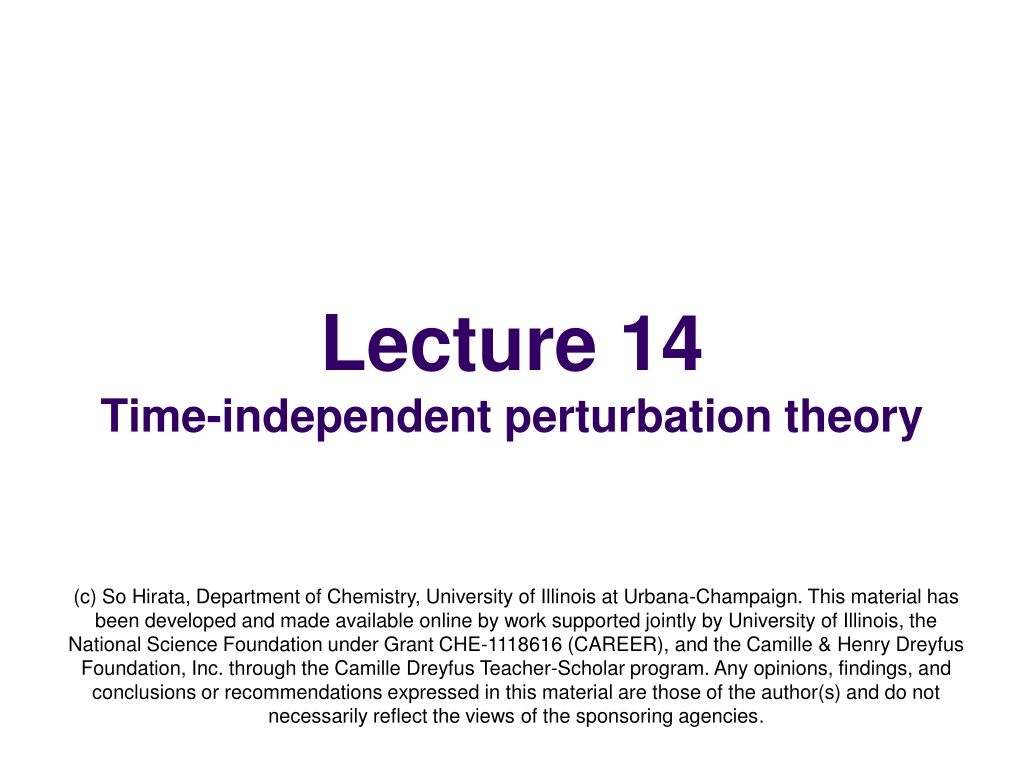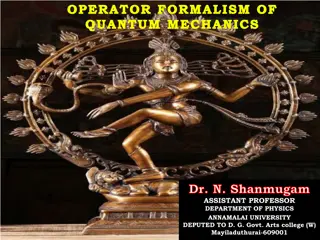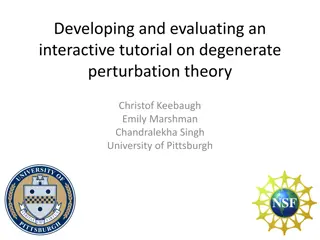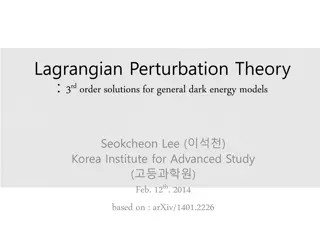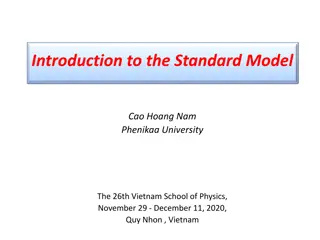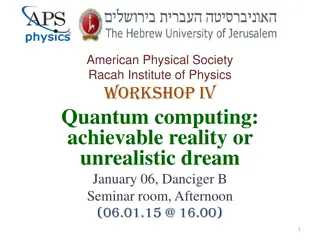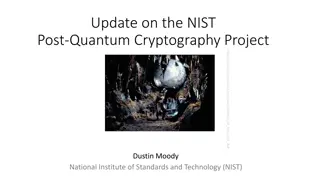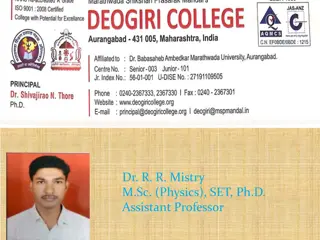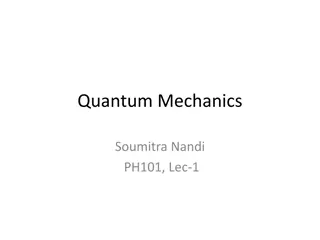Understanding Time-Independent Perturbation Theory in Quantum Mechanics
Perturbation theory is a powerful tool in solving complex physical and mathematical problems approximately by adjusting solutions from a related problem with known solutions. This theory allows for more accurate approximate solutions by treating the difference as a small perturbation. An example involving a bar bill illustrates how perturbation theory works. It plays a significant role in many-body theories and accurate numerical solutions of the Schrödinger equation, contributing to concepts like dipole moment, polarizability, and spin-orbit coupling. The theory involves identifying zeroth-order solutions, partitioning the Hamiltonian, and classifying terms.
Download Presentation

Please find below an Image/Link to download the presentation.
The content on the website is provided AS IS for your information and personal use only. It may not be sold, licensed, or shared on other websites without obtaining consent from the author. Download presentation by click this link. If you encounter any issues during the download, it is possible that the publisher has removed the file from their server.
E N D
Presentation Transcript
Lecture 14 Time-independent perturbation theory (c) So Hirata, Department of Chemistry, University of Illinois at Urbana-Champaign. This material has been developed and made available online by work supported jointly by University of Illinois, the National Science Foundation under Grant CHE-1118616 (CAREER), and the Camille & Henry Dreyfus Foundation, Inc. through the Camille Dreyfus Teacher-Scholar program. Any opinions, findings, and conclusions or recommendations expressed in this material are those of the author(s) and do not necessarily reflect the views of the sponsoring agencies.
Perturbation theory What is perturbation theory? To solve complex physical and mathematical problems approximately We first identify the most closely related problem (zeroth order) with known solutions, We then adjust the solutions by analyzing the difference. The main assumption is that the difference is only a small perturbation (disturbance) and we can obtain accurate approximate solutions more easily than solving the problem more exactly.
Example of perturbation theory 10 people went to a bar. Nine (9) of them (Group A) had one drink each and one (1) (Person B) had two drinks. The bill was $100. Each paid $10 (= $100 / 10 people) (zeroth order solution). Person B (who had two drinks - perturbation) felt bad and pitched in another $10 (first order perturbation solution). There is an overage of $10 and so $1 (= $10 / 10 people) is returned to each (second order perturbation solution). Each in Group A paid $9 and Person B paid $19, whereas the exact solution is, each in Group A pays $100/11 = $9.0909090909 and Person B pays $100/11 x 2 = $18.1818181818
Significance of the theory The most successful many-body theory. Most of the accurate numerical solutions of the Schr dinger equations (no exact analytical solutions) are based on this theory. Some of the physical quantities and concepts are based on perturbation theory: dipole moment (1st order), polarizability (2nd order), spin-orbit coupling theory (1st order), one-photon optical transitions (time-dependent 1st order), two-photon optical transitions (time-dependent 2nd order), just to name a few.
Zeroth order Suppose we want to know at least approximately the ground-state solution of the Schr dinger equation H = The ground state E 0 0 0 Suppose we have found a similar problem with a known solution H(0)Y0 Known solution (0), H(0) H (0)= E0 (0)Y0
Partitioning of Hamiltonian First we view H as the sum of H(0) and a perturbation = + = + (0) (1) (0) (1) H H H H H is equal to 1, and has no effect except it helps us classify terms 0th-order part The greater the number in parenthesis, the smaller the term. This term is a small perturbation as compared to (0) term Perturbation So far no approximation yet
Series expansions If we turn on H(1) in the Hamiltonian, the wave function and energy change the size of change that is linear, quadratic, cubic, etc. to the size of H(1) (cf. Taylor expansion) Y0= Y0 E0= E0 If we carry through this infinite summation, we get the exact solution of H 0=E0 0. So far, no approximation has been made. (0)+lY0 (0)+lE0 (1)+l2Y0 (1)+l2E0 (2)+ (2)+
Sizes of terms The powers in indicate the relative sizes of terms. For example, if the perturbation H(1) is 1% of H(0) in size, (1) is also roughly 1% of (0) and then (2) is 1% x 1% = 0.0001 of (0). We equate terms of roughly equal sizes. So, for example, the terms having 1 and 2 are very different in size and should not be compared.
The Schrdinger equation Substitute the Hamiltonian, wave function, energy into the Schr dinger equation that we intend to solve (not the zeroth-order one we already know the solution of). H = E 0 0 0 ( = E0 )Y0 (1)+l2E0 ( ) H(0)+l H(1) ( (0)+lY0 (1)+l2Y0 )Y0 (2)+ ( ) (0)+lE0 (2)+ (0)+lY0 (1)+l2Y0 (2)+
Order-by-order equations ( = E0 )Y0 (1)+l2E0 ( ) H(0)+l H(1) ( (0)+lY0 (1)+l2Y0 )Y0 (2)+ ( ) (0)+lE0 (2)+ (0)+lY0 (1)+l2Y0 (2)+ Equating the terms containing the same powers of , l0: H(0)Y0 l1: H(1)Y0 l2: H(1)Y0 This is nothing but the zeroth- order equation we started with. (0)= E0 (0)+ H(0)Y0 (1)+ H(0)Y0 (0)Y0 (0) (1)= E0 (2)= E0 (1)Y0 (2)Y0 (0)+ E0 (0)+ E0 (0)Y0 (1)Y0 (1) (1)+ E0 (0)Y0 (2)
First order Repeating this process, we obtain an infinite series of corrections the sum of which converge at the exact solution. Truncating the series constitutes an approximation. For example, if we stop at a finite order and solve the following first-order equation, then we obtain E(0) + E(1) as an approximation to true E. + = + 1 (1) (0) 0 (0) (1) 0 (1) 0 (0) 0 (0) 0 (1) 0 :H H E E
First order Now we expand the unknown wave function 0(1) as a linear combination of known wave functions { n(0)}. This is always possible because of the completeness of eigenfunctions of an Hermitian operator. { n(0)} [ground- and all excited-state wave functions of H(0)] forms a complete set. (1) 0 = (0) n c n n
First order Substituting + = + (1) (0) 0 (0) (1) 0 (1) 0 (0) 0 (0) 0 (1) 0 H H E E + = + (1) (0) 0 (0) (0) n (1) 0 (0) 0 (0) 0 (0) n H H c E E c n n n n (0)* 0 (0)* k Multiply or (k > 0) from the left and integrate over space + = + (0)* 0 (1) (0) 0 (0)* 0 (0) (0) n (1) 0 (0)* 0 (0) 0 (0) 0 (0)* 0 (0) n H d H c d E d E c d n n n n + = + (0)* k (1) (0) 0 (0)* k (0) (0) n (1) 0 (0)* k (0) 0 (0) 0 (0)* k (0) n H d H c d E d E c d n n n n
First order From the first equation: + = + (0)* 0 (1) (0) 0 (0)* 0 (0) (0) n (1) 0 (0)* 0 (0) 0 (0) 0 (0)* 0 (0) n H d H c d E d E c d n n n n 1 cancel exactly cancel exactly = = = (0)* 0 (0) (0) n (0)* 0 (0) (0) n (0) n (0)* 0 (0) n (0) 0 H c d c H d c E d c E 0 n n n n n n c0 contribution cancels exactly and it is simply repeating the 0 equation = (0) 0 (0)* 0 (0) n (0) 0 E c d c E 0 n n H = (0)* 0 (1) (0) 0 (1) 0 d E
First order From the second equation + Yk (1)Yk cnYk (0)* H(1)Y0 (0)* H(0) Yk (0)dt cnYn dt = E0 (0)*Y0 (0)dt + E0 (0)*Yn (0)dt (0) (0) n n 0 En (0)Yk (0)* H(0) (0)* H(0)Yn Yk cnYn dt = Yk (0)dt = (0)*Yn (0)dt = ckEk (0) (0) cn cn n n n cnYk (0)*Yn (0)dt = ckE0 (0) (0) E0 + = (0)* k (1) (0) 0 (0) k (0) 0 H d c E c E n k k (0)* k E (1) (0) 0 H d = c k (0) 0 (0) k E
Second order + = + + (1) (1) 0 (0) (2) 0 (2) 0 (0) 0 (1) 0 (1) 0 (0) 0 (2) 0 H H E E E Multiply from the left and integrate over space 0 = E0 (0)* cancel (0)* H(1)Y0 (0)* H(0)Y0 + E0 Y0 dt + Y0 (2)dt (1) (0)Y0 (2)Y0 (0)*Y0 (0)dt (1)Y0 (0)*Y0 (1)dt + E0 (0)*Y0 (2)dt 1 (1)Y0 (0)* H(1)Y0 (2)= Y0 (1)dt - E0 ckYk dt (0)* (0) E0 k = Y0 -c0Y0 (0)* H(1) (0)* H(1)Y0 ckYk dt (0)dt (0) k 2 (0)* H(1)Y0 E0 (0)* H(1)Yk (0)* H(1)Y0 Yk (0)dt Y0 (0)dt E0 Yk (0) (0)dt = = (0)- Ek (0)- Ek (0) k 0 k 0
First order This looks like an expectation value of the perturbation operator. H = (0)* 0 (1) (0) 0 (1) 0 d E
Second order Excited De-excited 1st-order WF (0)* 0 (1) (0) k E (0)* k (1) (0) 0 H d H d = (2) 0 E (0) 0 (0) k E 0 k Excited - deexcited
Summary Perturbation theory works as follows: Find a suitable zeroth-order Hamiltonian (close to the true Hamiltonian) whose eigenfunctions and eigenvalues are known. Partition the Hamiltonian into the zeroth-order part and perturbation. Expand the energy and wave function into series of smaller and smaller corrections to zeroth-order quantities. Equate the terms according to the sizes. Use completeness, normalization,and orthogonality of zeroth-order eigenfunctions to obtain general expressions for energies and wave functions.
